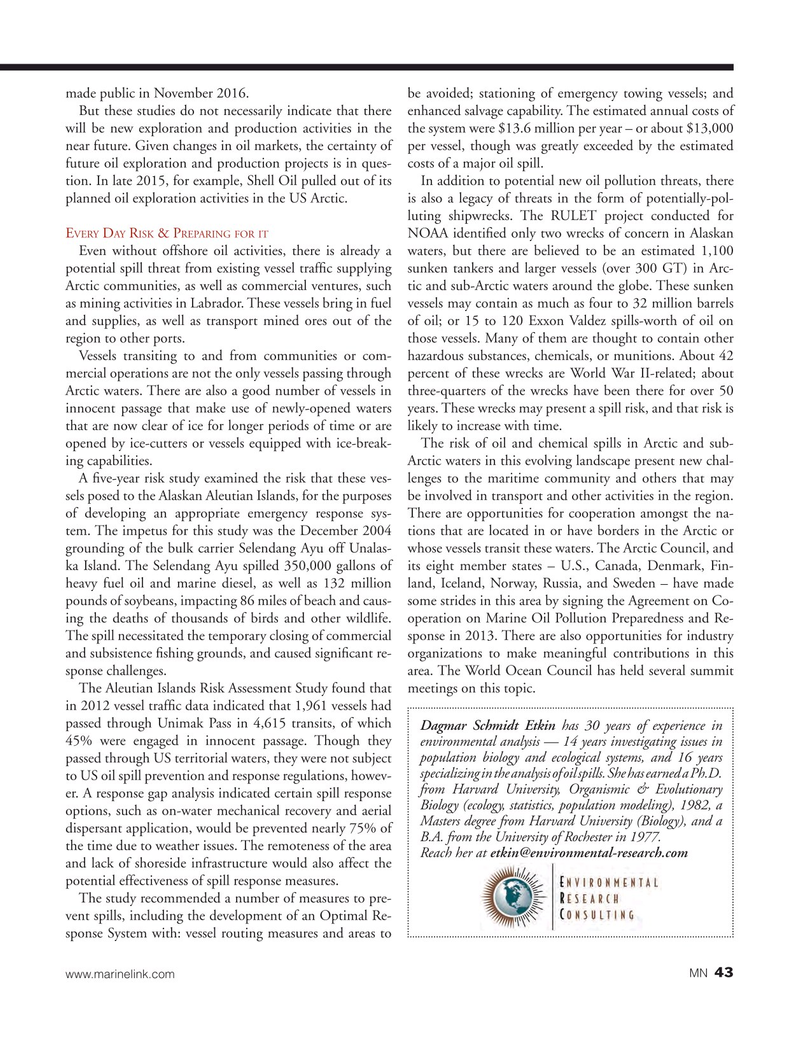
Page 43: of Marine News Magazine (October 2016)
Salvage & Spill Response
Read this page in Pdf, Flash or Html5 edition of October 2016 Marine News Magazine
made public in November 2016. be avoided; stationing of emergency towing vessels; and
But these studies do not necessarily indicate that there enhanced salvage capability. The estimated annual costs of will be new exploration and production activities in the the system were $13.6 million per year – or about $13,000 near future. Given changes in oil markets, the certainty of per vessel, though was greatly exceeded by the estimated future oil exploration and production projects is in ques- costs of a major oil spill.
tion. In late 2015, for example, Shell Oil pulled out of its In addition to potential new oil pollution threats, there planned oil exploration activities in the US Arctic. is also a legacy of threats in the form of potentially-pol- luting shipwrecks. The RULET project conducted for
VERY AY ISK REPARING FOR IT
E D R & P NOAA identi? ed only two wrecks of concern in Alaskan
Even without offshore oil activities, there is already a waters, but there are believed to be an estimated 1,100 potential spill threat from existing vessel traf? c supplying sunken tankers and larger vessels (over 300 GT) in Arc-
Arctic communities, as well as commercial ventures, such tic and sub-Arctic waters around the globe. These sunken as mining activities in Labrador. These vessels bring in fuel vessels may contain as much as four to 32 million barrels and supplies, as well as transport mined ores out of the of oil; or 15 to 120 Exxon Valdez spills-worth of oil on region to other ports. those vessels. Many of them are thought to contain other
Vessels transiting to and from communities or com- hazardous substances, chemicals, or munitions. About 42 mercial operations are not the only vessels passing through percent of these wrecks are World War II-related; about
Arctic waters. There are also a good number of vessels in three-quarters of the wrecks have been there for over 50 innocent passage that make use of newly-opened waters years. These wrecks may present a spill risk, and that risk is that are now clear of ice for longer periods of time or are likely to increase with time.
opened by ice-cutters or vessels equipped with ice-break- The risk of oil and chemical spills in Arctic and sub- ing capabilities. Arctic waters in this evolving landscape present new chal-
A ? ve-year risk study examined the risk that these ves- lenges to the maritime community and others that may sels posed to the Alaskan Aleutian Islands, for the purposes be involved in transport and other activities in the region. of developing an appropriate emergency response sys- There are opportunities for cooperation amongst the na- tem. The impetus for this study was the December 2004 tions that are located in or have borders in the Arctic or grounding of the bulk carrier Selendang Ayu off Unalas- whose vessels transit these waters. The Arctic Council, and ka Island. The Selendang Ayu spilled 350,000 gallons of its eight member states – U.S., Canada, Denmark, Fin- heavy fuel oil and marine diesel, as well as 132 million land, Iceland, Norway, Russia, and Sweden – have made pounds of soybeans, impacting 86 miles of beach and caus- some strides in this area by signing the Agreement on Co- ing the deaths of thousands of birds and other wildlife. operation on Marine Oil Pollution Preparedness and Re-
The spill necessitated the temporary closing of commercial sponse in 2013. There are also opportunities for industry and subsistence ? shing grounds, and caused signi? cant re- organizations to make meaningful contributions in this sponse challenges. area. The World Ocean Council has held several summit
The Aleutian Islands Risk Assessment Study found that meetings on this topic. in 2012 vessel traf? c data indicated that 1,961 vessels had passed through Unimak Pass in 4,615 transits, of which
Dagmar Schmidt Etkin has 30 years of experience in 45% were engaged in innocent passage. Though they environmental analysis — 14 years investigating issues in passed through US territorial waters, they were not subject population biology and ecological systems, and 16 years specializing in the analysis of oil spills. She has earned a Ph.D. to US oil spill prevention and response regulations, howev- from Harvard University, Organismic & Evolutionary er. A response gap analysis indicated certain spill response
Biology (ecology, statistics, population modeling), 1982, a options, such as on-water mechanical recovery and aerial
Masters degree from Harvard University (Biology), and a dispersant application, would be prevented nearly 75% of
B.A. from the University of Rochester in 1977. the time due to weather issues. The remoteness of the area
Reach her at [email protected] and lack of shoreside infrastructure would also affect the potential effectiveness of spill response measures.
The study recommended a number of measures to pre- vent spills, including the development of an Optimal Re- sponse System with: vessel routing measures and areas to 43 www.marinelink.com MN
MN Oct16 Layout 32-49.indd 43 9/21/2016 3:27:08 PM

 42
42

 44
44
